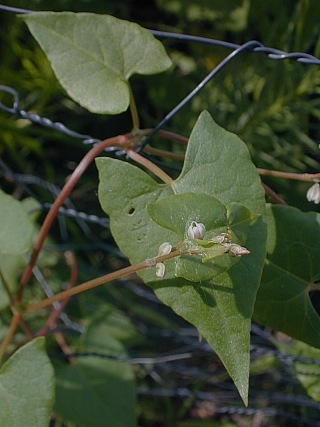Description: This vine is a summer annual up to 8' long. It branches frequently at the base and less often elsewhere. The slender stems are light green to reddish green and hairless. They have the capacity to twine about the stems of adjacent plants and the wire of fences. The alternate leaves are widely spaced along the stems and have long slender petioles. They are up to 2½" long and 1" across, cordate or sagittate, smooth along the margins, and hairless. Their texture is rather thin and delicate. At the base of each petiole is a membranous sheath (ocrea) that wraps around the stem. This sheath is rather short and hairless.

Individual
or pairs of flowers develop from the axils of the upper leaves on short
slender petioles. Short terminal racemes of flowers about 1-2" long
also develop from some of the upper stems. These flowers are about ¼"
long and have 3-5 petal-like sepals that are greenish white, white, or
light pink. Each sepal is slightly keeled along its outer surface. Each
flower matures into a 3-angled achene that is oblong, but widest in the
middle. It is only slightly winged or keeled. The flowers develop and
mature rather quickly on young stems where new growth occurs. The
blooming period occurs during the summer and lasts 2-3 months. Each
fertile flower is replaced by a large black achene that is 3-sided; the
surface of this achene is dull along the sides, but shiny along the
angles. The root system consists of a slender branching taproot. This
plant spreads by reseeding itself.
Cultivation:
Full or partial sunlight, mesic conditions, and fertile loamy soil are
preferred, although this plant can be found on poor soil as well.
Germination of the seeds doesn't occur until late spring or early
summer, but once it begins, the growth of the vines is rapid. Even
small vines can produce viable seeds in a short period of time.
Range & Habitat:
The non-native Black Bindweed (Fallopia convolvulus) is a common plant in central and northern
Illinois, but
less common or absent in some southern areas of the state (see Distribution
Map). Habitats include cropland, fallow fields, fence rows,
gardens and edges of yards, areas along railroads and roadsides, and
miscellaneous waste areas. This plant is adventive from Eurasia. It is
a common pest where the soil has been turned over for the cultivation
of crops, vegetables, or annual flowers.

Faunal Associations:
The flowers of Black Bindweed (Fallopia convolvulus) are visited by
Halictid bees, Andrenid bees, wasps, and bee flies (Krombein et al.,
1979; Wilhelm & Rericha, 2017). These insect seek mostly nectar
from the flowers, although some of the bees may also collect pollen.
Other insects feed destructively on the foliage and other parts of this
plant. Such insect feeders include Chaetocnema concinna (Brassy Flea Beetle), Gastrophysa polygoni (Knotweed Leaf Beetle), Macrosiphum venaefuscae (an aphid), and larvae of the moth, Timandra amaturaria (Cross-lined
Wave); see Clark et al. (2004), Marcovitch (1916), Blackman &
Eastop (2013), and Wagner (2005). The seeds of Black Bindweed and other
Fallopia spp. are eaten by the
Mourning Dove, Greater Prairie Chicken, and probably many other birds
(Lewis, 1993; Yeatter, 1943). The seeds of these herbaceous vines are
also eaten by small rodents, such as the White-footed Mouse and Deer
Mouse (Hamilton, 1941).
Photographic Location:
Along a wire fence of the wildflower garden at the webmaster's
apartment complex in Urbana, Illinois.
Comments:
The foliage and vine-like growth of Black Bindweed has a striking
resemblance to the Convolvulus spp. (Bindweeds) and
Ipomoea spp. (Morning Glories). However, Black
Bindweed is a shorter and less robust vine and its flowers have a
dramatically different appearance from the flowers of the preceding
species. The Fallopia spp. (Climbing Buckwheats)
are vines with a climbing habit, unlike the closely related Persicaria
spp. (Smartweeds) and Polygonum spp.
(Knotweeds). Unlike Black Bindweed, the other Fallopia spp.
that occur in Illinois are robust perennial vines that can become 20'
long. Like many Rumex spp. (Docks), their achenes
have conspicuous membranous wings, while the keeled achenes of Black
Bindweed are without wings. Another scientific name for Black Bindweed
is Polygonum convolvulus.